A summary of interesting guitar amp and sound equipment projects...

Example One | Late 50's Watkins Dominator Model 20/T Valve Guitar Amp...
This little beauty came to me from a third-party trade customer. It was rescued from a garden shed during a clear out in preparation for a house move. My diagnostic revealed that a number of Hunts capacitors and carbon resistors were out of value due to ageing. The smoothing/filter capacitors were also well past their usefulness.
This very rare 17 watt, 2 x 10 vintage valve amp was in desperate need of repair!

Having given a quote and gotten consent from the customer, I proceeded to perform a partial rebuild. Components were replaced or upgraded as required using Mustard type capacitors and carbon film or carbon comp resistors. Smoothing/filter caps were mounted on a tag strip (due to the fact that no suitable replacement to match the original could be sourced) and input jacks replaced with new Cliff types. Using stock to hand, the old Brimar valves were replaced with Electro Harmonix types for output stage and JJ for the preamp/phase splitter stages – not forgetting the valve rectifier.
Before | Work in progress
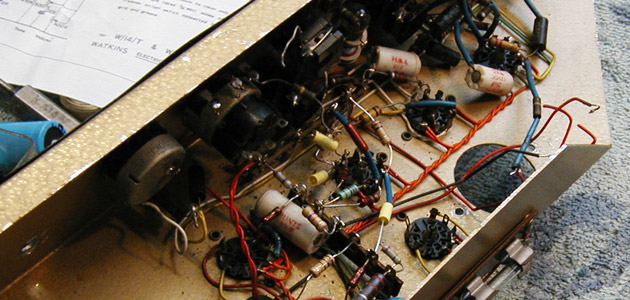
After | Serviced with several internal components replaced
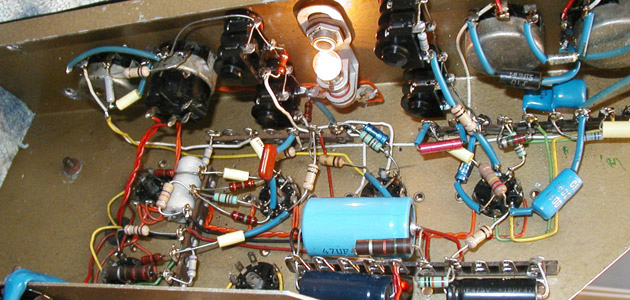
The conclusion was that this little vintage valve amp sounded great and was well worth the effort, given it's age.

Example Two | Early 70's Fender Bassman 50w Valve Guitar Amp Head...
This classic from the early 70s came to me with some very typical symptoms of a neglected amp that had been stored in less than ideal circumstances (don't store electrical items is a cold, damp shed!). There was visible rust on the internal chassis area around the tag board, but fortunately hadn't compromised the structural integrity, grounding and circuit connections in any way.
The Fender Bassman Silverface - classic guitar valve amps increasing in value and popularity

Sovtec (output) and JJ (preamp) valves fitted, plus new control pots throughout
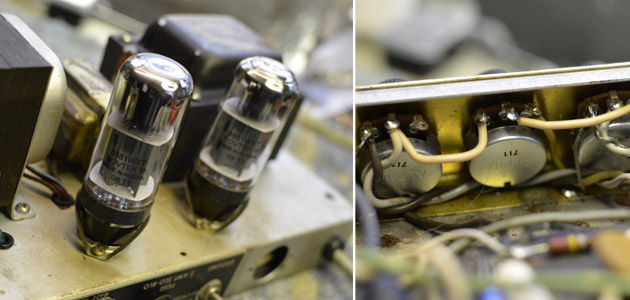
All of the control pots were replaced, along with the smoothing/filter capacitors, decoupling capacitors and any out of value resistors, where applicable. High quality replacement parts were sourced from Tube Amp Doctor. Sovtec valves and JJ were also fitted.
New smoothing capacitors fitted (left) replacement control pot knobs (right)
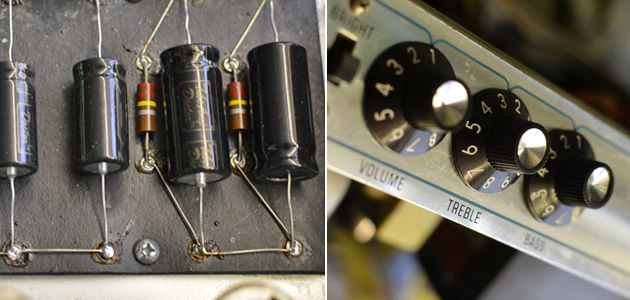
On further testing, it became apparent that the output transformer was faulty and needed replacing. At this point, the client asked if it would be possible to upgrade the original 4ohm rated output, as is standard for the Fender Bassman. The reason being that it would allow for more flexible options when choosing a partnering speaker cabinet, most of which are rated either 8 or 16 ohms. My thoughts were to opt for a Hammond output transformer that matched the original Fender specification, but allowed for hard wiring to either a 4, 8 or 16 ohm output. Alternatively, it could also be fitted to a 3-way selector switch to make all output impedance options available. The option of hard wiring for 8 ohm was chosen to reduce the amount of modification on the amp and also keep costs within budget.
Cosmetically, missing/damaged chassis straps and control pot knobs were also replaced. In all, the end result is a great looking 40 year old valve amp with a superb, classic Fender tone!

Example Two (part two) | Early 70's Fender Bassman Blackface conversion...
After the amp had been tested at higher volumes during a few live gigs, it became evident there were issues with excessive noise, crackles and pops. This was diagnosed as a faulty eyelet board, which had effectively deteriorated to the point the surface material had become conductive - therefore causing random, erratic noise. After discussion with the client, it was decided that the best course of action would be to rebuild the eyelet componant board entirely from scratch, using new components.

Sprague 'Orange Drop' caps were used throughout
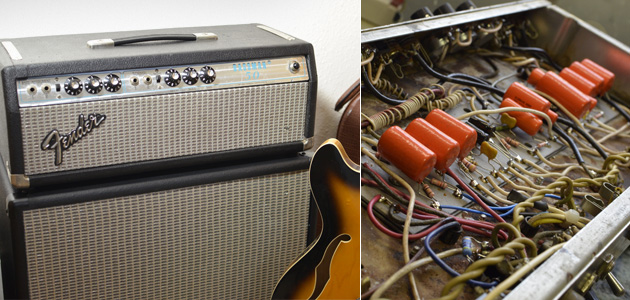
As a complete rebuild was in order, it was the perfect opportunity to upgrade the original AA371 circuit and convert it to a more stable, arguably better AA165 circuit design - which is the general consensus of opinion amongst amp techs and builders. Sprague 'Orange Drop' capacitors were used throughout, plus a number of resistor upgrades. The original hum balance circuit was also reconfigured as a workable bias adjustment pot, again, a popular upgrade for this type of valve amp. Finally, a humdinger pot was fitted to minimise a slight increase in heater circuit hum as a result of the changes.

On recent tests, the client has reported a significant improvement in noise reduction, plus an improvement in tone and playing dynamics. Altogether, a really nice old classic Fender valve amp!

